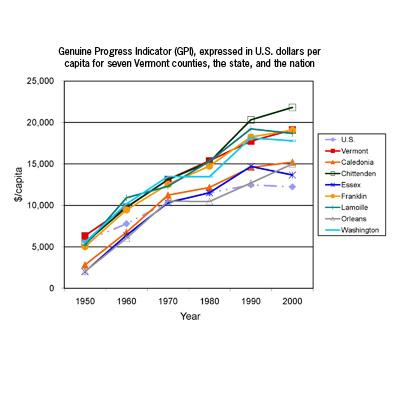Measuring Socio-Economic Well-Being in the Northern Forest

Measuring a community’s quality of life from year to year is key to development and revitalization planning. The well-being of the Northern Forest depends on the economic vitality of its communities as well as its natural resource wealth and social health. Yet, classical measures of progress, such as the Gross Domestic Product (GDP), are based solely on economic growth, ignoring environmental or social costs.
NSRC researchers used an alternative measure of progress, the Genuine Progress Indicator (GPI), to monitor socio-economic well-being over the past 50 years in six rural counties of Vermont and more urban Chittenden County. The GPI, expressed in U.S. dollars per capita, adjusts for non-monetary activities that increase well-being (e.g. volunteer work) as well as those that have a negative effect on quality of life, such as crime or underemployment.
Researchers determined Vermont’s per capita GPI is greater than the U.S. average, with Chittenden County having the highest GPI of any Vermont county. GPI in the most rural counties (Caledonia, Essex, Orleans) was below the U.S. average in 1950 but had risen above the national average by 2000. For all Vermont counties studied, per capita GPI has increased at a faster rate than the U.S. average, suggesting that growth in Vermont’s consumption has not led to social and environmental inequality. Vermont’s rural counties generally had lower income and personal consumption, generated less solid waste, and had less air, water, and noise pollution and less loss of forest cover and wetlands. The same counties had consistently lower crime rates but higher costs of underemployment.
Download printable version [PDF]
Download full final report [PDF]
